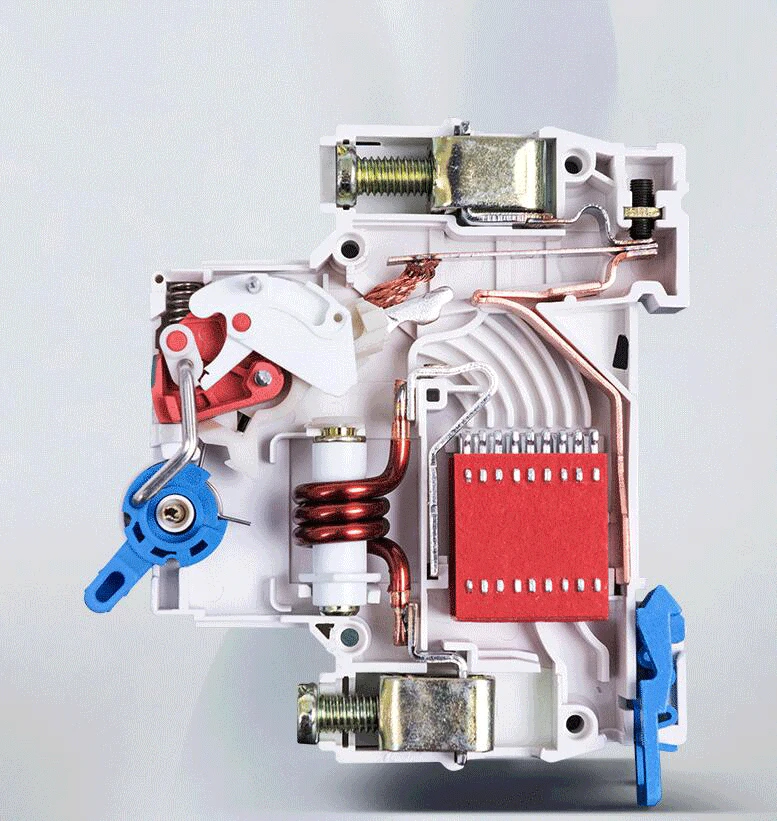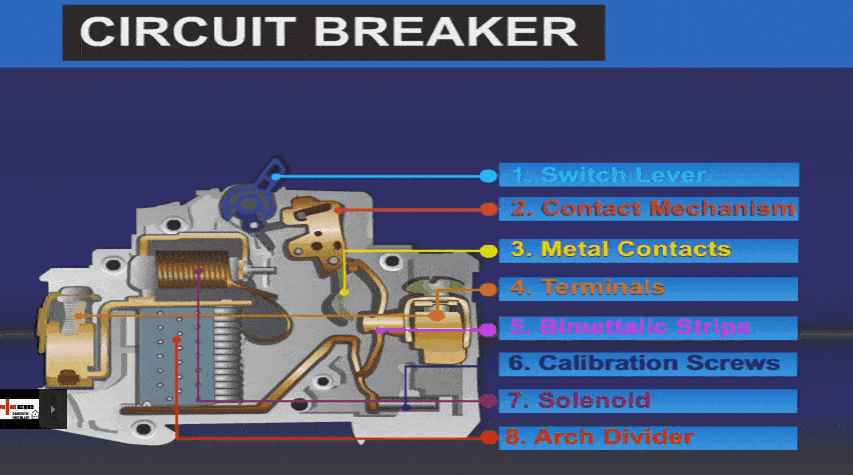A tiny interesting device called an M. C. B. protects you in your house from electrical mishaps this breaker saves you from 2 situations first overload and second short circuit conditions. In a short circuit scenario the M. C. B. trips in less than 3 milliseconds and isolates the internal connections. Let's see how this smart device detects current chaos so quickly and precisely. A simple device called a fuse which has a low melting point wire was used for home protection in earlier days. In both the fault conditions mentioned previously the current spikes up resulting in overheating and fusing the wire or breaking the circuit. However every time the fuse would blow you had to manually replace it until you could do that good luck with the blackout this commonly occurring situation is why circuit breakers were invented.
The circuit breaker is an automatic on off mechanism that keeps one side of the wire moving and the other fixed. If the circuit opens during an electric fault we are done with the M. C. B. design after the fault ends simply manually turn it on before getting more into the M. C. B. design a small note about the current direction and M. C. B. gets activated in less than 3 milliseconds which is way lower than the half cycle time period of an alternating current so it is okay to show the current flow in a single direction throughout the analysis. Now the question is how does the system recognize the occurrence of an electric fault the answer is that it has a triggering mechanism. And a sensing element when it encounters a small input movement this mechanism makes a big movement and opens the circuit a clever mechanism to achieve this objective is shown here this mechanism has a lever to which a rectangular ring is connected as shown the rectangular ring is connected by 2 springs and the central lever as shown. In this position both the springs are in a neutral state when the lever moves up the bottom spring compressors and the top spring expands. The forces of both the springs are eventually transferred to the lever via the rectangular ring and this force will be in the upper direction. As you can see the rectangular spring is initially had a negative offset to the center of the lever. When you pushed the lever up the negative offset will produce a clockwise torque and bring the lever back to the initial position. However if you pushed the lever father rob. Do you notice anything peculiar about the offset distance. It suddenly becomes positive which means that after a critical limit the torque will act on it in a counter clockwise direction. When the M. C. B. as on this will be the position of the lever. The structure of the MCB will block the lever from rotating counter clockwise.
Now if an external trigger turns the lever slightly the torque on the lever suddenly becomes clockwise and the circuit opens wide quickly without the need of an external force. Here as the operator pushes the lever down you can see an ultra slow motion how the mechanism operates in practice. After a small angle the lever generates its own torque and then there is no need to apply external force. Now the only question is how can we generate this small input trigger or input motion when a fault occurs. The best answer is with an electromagnet. This coil produces magnetic fields proportional in nature to the current passing through them as the current increases the magnetic field becomes stronger throughout the video no that in the case of a short circuit the current rises up to 1000 times in magnitude within milliseconds.
This results generates a very strong magnetic field and iron cylinder is inside this electromagnet slightly offset from its center it is rested on a spring with a pen the magnetic field polls the cylinder downward thus pushing the pen. This tiny movement of the pen is the input trigger of the mechanism we explained earlier and it leads to opening the circuit as we also discussed earlier you might be wondering in normal current flow why isn't the cylinder attracted down well the force in normal current flow is not high enough to overcome spring tension whereas short circuit current can go up to 10 to 100 times the normal current the force is quite high so the circuit trips. The danger of fault is not over yet folks. As soon as the contacts are opened the current doesn't just stop flowing the fault current is of large value and will lead to air discharge or current will flow through the air it is an amazing to watch and yet hazardous arc to extinguish the arc a component called an arc runner or arc shoot is used.
The arc shoot is an arrangement of parallel plates arrange that small intervals as the contact separate the heavy fault current flowing as an arc triggers a huge temperature rise that can cause damage therefore this arc should be killed resistance increases with length and decreases with area here we need increased resistance of the current which passes through air which is why the distance between the contact point is kept high after the circuit opens since the air is hot this arc will be pushed up later the arc is divided into small chunks thus reducing its area with increased resistance the arc dies away at current 0.
An overload happens if you find yourself using a number of appliances at once since all the appliances in our houses are connected in parallel such a scenario will lead to an increase in current this is another dangerous scenario which we need to prevent the current flow during a short circuit rises by 10 to 100 times the rated current but in overload it only rises 2 to 5 times. You might think that use of a separate electromagnet with lesser operating rating may solve this issue but it won't let's see why. The problem with this new coal oil for an overload condition is that it will get activated even if you simply start another electrical appliance fluorescent tubes for example carry an inrush current during start up that maintains for about 10 milliseconds and then goes back to normal therefore using a lower rated electro magnet will cause the breaker to trip unnecessarily when you start electrical appliances. A perfect choice to solve the overload condition is a bi metallic strip this sensor is a bit slower and offsets in rush currents as it stays around for only 10 milliseconds however it trips the NCB when the overload current maintains for 2 seconds or more. In a bi metallic strip as the current rises he causes the strip to bend slowly this occurrence pushes a C. shaped lever and thus the main lever down ended there by opens the contacts. The current value on which the bi metallic strip should operate can be varied with this group which is only adjusted by manufacturers we hope you have now developed a good understanding of a miniature breaker. With this precisely designed device you are safe from electrical disasters apart from M. C. B. we have other breaker types designed for different types of faults E. L. C. B. and M. C. C. B.



